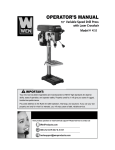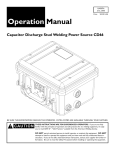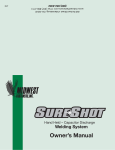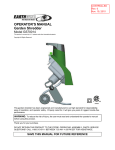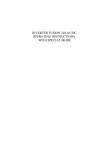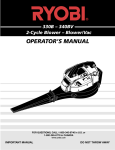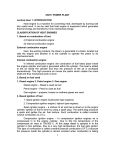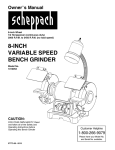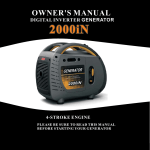Download Ryobi 310r Blower User Manual
Transcript
Model 310r Blower Model 310BVr Blower Vac OPERATOR’S MANUAL IMPORTANT FOR STARTING INSTRUCTIONS REFER TO PAGE 10 IMPORTANT MANUAL DO NOT THROW AWAY 1 TABLE OF CONTENTS INTRODUCTION THANK YOU Thank you for purchasing this quality product. This modern power tool has been designed to provide you with many hours of useful service. You will find it to be a great labor-saving device. I. California Emission Regulations ................................3 II. Safety Warnings ......................................................3-5 A. Operational ........................................................3-4 B. Safety and International Symbols ......................4-5 III. Assembly Instructions ............................................6-8 A. Blower Tube and Nozzle Assembly ......................6 B. Installing the Vacuum Bag Assembly (Optional for Model 310r) ......................................6 C. Installing the Adapter (Optional for Model 310r) ......................................7 D. Installing the Vacuum Tubes (Optional for Model 310r)....................................7-8 IV. Oil and Fuel Information ............................................9 V. Starting/Stopping Instructions..................................10 VI. Operating Procedures ..............................................11 A. Typical Operating Positions ................................11 B. Vacuum Operating Procedures (Optional for Model 310r) ....................................11 This manual has been prepared to provide you with common sense operating instructions and to ensure that you will get maximum satisfaction. To keep your unit in top operating condition, use the maintenance and service procedures in this manual. PRODUCT REFERENCES, ILLUSTRATIONS AND SPECIFICATIONS All information, illustrations and specifications in this manual are based on the latest product information available at the time of printing. We reserve the right to make changes at any time without notice. SERVICE INFORMATION Service on this power equipment within and after the warranty period can be performed by any Authorized Service Dealer. Dial 1-800-345-8746 in the United States and 1-800-265-6778 in Canada to obtain the listing of servicing dealers in your area. DO NOT RETURN UNIT TO RETAILER. NOTE: PROOF OF PURCHASE WILL BE REQUIRED FOR WARRANTY SERVICE. MAKE SURE THIS MANUAL IS CAREFULLY READ AND UNDERSTOOD BEFORE STARTING OR OPERATING THIS EQUIPMENT. 2 VII. Maintenance and Repair ....................................12-16 A. Maintenance Schedule ........................................12 B. Air Filter Maintenance ....................................12-13 C. Carburetor Adjustment ..................................13-15 D. Replacing the Spark Plug ....................................15 E. Inspecting/Cleaning the Muffler......................15-16 VIII. Cleaning and Storage ..............................................17 IX. Specifications ..........................................................17 X. Troubleshooting ........................................................18 XI. California Emission Control Warranty Statement ....19 XII. Warranty Statement ................................................20 California Proposition 65 Warning: CALIFORNIA EMISSION REGULATIONS The engine of your lawn and garden care product meets the 1995 California emissions regulations. To ensure that your unit continues to meet these regulations, refer to the following information and instructions in this operator's manual. These units are identified by the label on the engine of your product. A typical identification label is shown. SAFETY WARNINGS THE PURPOSE OF SAFETY SYMBOLS IS TO ATTRACT YOUR ATTENTION TO POSSIBLE DANGERS. THE SAFETY SYMBOLS, AND THE EXPLANATIONS WITH THEM, DESERVE YOUR CAREFUL ATTENTION AND UNDERSTANDING. THE SAFETY WARNINGS DO NOT BY THEMSELVES ELIMINATE ANY DANGER. THE INSTRUCTIONS OR WARNINGS THEY GIVE ARE NOT SUBSTITUTES FOR PROPER ACCIDENT PREVENTION MEASURES. SYMBOL MEANING DURING OPERATION • Wear safety glasses or goggles at all times when operating the unit. • Dress properly. Do not operate the unit when barefoot or wearing open sandals. Always wear sturdy, rubbersoled footwear. The use of gloves, ear/hearing protection, and long pants are recommended. • Do not wear loose-fitting clothing, or loose articles such as scarves, strings, chains, ties, etc. because they could get drawn into the air intake. Also make sure long hair does not get drawn into the air intake. • Keep hands, face and feet away from all moving parts. • Rotating impeller blades can cause severe injury. Stop the engine before opening the vacuum door or installing/changing tubes. Do not put hands or any other object into the vacuum tubes while they are installed on the unit. • Do not touch the muffler or cylinder. These parts get extremely hot from operation and remain hot for a short time after the equipment is turned off. • Operate the unit only in a well-ventilated area, outdoors. Carbon monoxide exhaust fumes can be lethal in a confined area. • Inspect the area before starting the unit. Remove all debris and hard or sharp objects such as rocks, glass, wire, etc. WARNING: Failure to obey a safety warning can result in injury to yourself and others. NOTE: Advises you of information or instructions vital to the operation or maintenance of the equipment. FUELING AND PRE-OPERATION • Gasoline is extremely flammable and its vapors can explode if ignited. Always stop the engine and allow it to cool before filling the fuel tank. Do not smoke while filling the fuel tank. Keep sparks and open flames away from the area. • Store the gasoline and fuel only in containers designed and approved for the storage of such materials. • Pressure can build up in the fuel tank. Loosen the fuel tank cap slowly to relieve any pressure in the tank. • Add fuel in a clean, well-ventilated area. Wipe up any spilled fuel immediately. If fuel has been spilled, allow it to dry completely before starting the engine. • Do not point the blower in anyone’s direction or in the direction of windows. The blower can propel objects at high speed. • Move the unit at least 10 ft (3 m) from the fueling point before starting the engine. • Do not wear rubber or other insulated gloves when using the unit to avoid static electricity shock. • Thoroughly inspect the unit for loose or damaged parts before each use. Do not use until adjustments or repairs are made. • Do not overreach. Keep proper footing and balance at all times. • Never run the unit without the proper equipment attached. When used as a blower, always install the blower tube. When used as a vacuum, always install the suction tubes and collection bag assembly. Make sure the collection bag is completely zipped when the • Avoid accidental starting. Be in the starting position whenever pulling the starting rope. • Keep all bystanders, especially children, and pets at least 30 ft (10 m) away from the area. 3 SAFETY WARNINGS (Continued) the unit. unit is running to avoid flying debris. • Avoid situations that could catch the collection bag on fire. Do not operate near an open flame. Do not vacuum warm ash from fireplaces, barbeque pits, brush piles, etc. Do not vacuum discarded cigars or cigarettes unless the cinders are completely cool. • Use the right tool. Do not use this unit for any job except that for which it is intended. • Always remain alert. To prevent injury to yourself and others, do not operate this unit if you are fatigued. • Use only genuine replacement parts when servicing this unit. These parts are available from your authorized dealer. The use of non-standard parts, or other accessories or attachments not designed for this unit could result in serious injury to the user or damage to AFTER OPERATION • Turn off the engine and let it cool before refueling or before putting the unit in storage. • Store the unit in an upright position on the feet provided. • Store the unit in an area free of potential fuel vapor ignition sources such as open flames (pilot lights) or electrical sparking devices (switches, electric motors). SAFETY AND INTERNATIONAL SYMBOLS This operator's manual describes safety and international symbols and pictographs that may appear on this product. Read the operator's manual for complete safety, assembly, operating and maintenance and repair information. SYMBOL SIGNIFICATION • SAFETY ALERT SYMBOL. Indicates caution, warning or danger. May be used in conjunction with other symbols or pictographs. • READ OPERATOR'S MANUAL. Failure to follow operating instructions and safety precautions in operator's manual can result in serious injury. Read operator's manual before starting or operating this unit. • WEAR EYE AND HEARING PROTECTION. Warning. Thrown objects and loud noise can cause severe eye injury and hearing loss. Wear ear and eye protection when operating this unit. • FOR SERVICE INFORMATION, CALL: USA: 1-800-345-8746 CANADA: 1-800-265-6778 • INDICATES OIL. Refer to operator's manual for the proper type of oil. 4 SAFETY WARNINGS (Continued) SYMBOL SIGNIFICATION • UNLEADED FUEL. Always use clean, fresh unleaded fuel. • PRIMER BULB. Push primer bulb, fully and slowly, 5 to 7 times. • CHOKE CONTROL. FULL CHOKE position. • CHOKE CONTROL. PARTIAL CHOKE position. • CHOKE CONTROL. RUN position. I O • IGNITION / POWER SWITCH. ON / START / RUN • IGNITION / POWER SWITCH. OFF OR STOP • HOT SURFACE WARNING. Do not touch a hot muffler, gear box or cylinder. You may get burned. These parts get extremely hot from operation and remain hot for a short time after the unit is turned off. • BLOWERS AND BLOWER / VACUUMS – ROTATING BLADES CAN CAUSE SEVERE INJURY. Stop the engine or motor before opening the vacuum door or installing / changing tubes. Do not put hands or any other objects into the vacuum tubes while they are installed on this unit. 5 ASSEMBLY INSTRUCTIONS BLOWER TUBE AND NOZZLE ASSEMBLY - BOTH MODELS NOTE: Do not install tubes while unit is running. 1. Align the grooves in the blower tube with the pins in the blower outlet. 2. Grasping the tube firmly with both hands, push the tube into the blower outlet (Fig. 1). Turn the tube clockwise until it snaps into the detent and locks. INSTALLING THE VACUUM BAG/TUBE ASSEMBLY (OPTIONAL FOR MODEL 310r) WARNING Rotating impeller blades can cause severe injury. Do not attempt to convert the unit while the engine is running to avoid serious personal injury. Do not put hands or any other object into the vacuum tubes while they are installed on the unit. 1. Remove the blower tubes. 2. Align the grooves in the vacuum bag/elbow tube assembly with the pins in the blower outlet. 3. Grasping the tube firmly with both hands, push the vacuum bag/elbow tube assembly into the blower outlet (Fig. 3). Turn the assembly clockwise until it snaps into the detent and locks. The curve of the tube should angle upwards. Fig. 1 3. Align the pins of the blower nozzle with the grooves in the blower tube (Fig. 2). 4. Grasping the nozzle firmly with both hands, push the nozzle onto the blower tube. Turn the nozzle clockwise until it snaps into the detent and locks. NOTE: The blower tube and nozzle or vacuum bag must be used at all times to prevent overheating the engine. Fig. 3 Fig. 2 6 ASSEMBLY INSTRUCTIONS (Continued) INSTALLING THE ADAPTER ONTO THE UPPER VACUUM TUBE - (OPTIONAL FOR MODEL 310r) NOTE: 3. Align the adapter's three (3) slots with the unit's three (3) hooks. Push firmly so all three (3) hooks snap through (Fig. 7). Do not install while unit is running. 1. Turn the blower upside down as shown in Fig. 4. Hold the blower between your knees to install the adapter and vacuum tubes. Fig. 7 4. Align the arrow on the upper tube with the arrow on the adapter. Slide the upper vac tube onto the adapter (Fig. 8). NOTE: Fig. 4 The arrows must align properly to install the vacuum tubes correctly. 2. Push the door lock tab in the direction shown in Fig. 5 and open the door (Fig. 6). Tab Fig. 8 Fig. 5 Fig. 6 7 ASSEMBLY INSTRUCTIONS (Continued) 5. Grasping the upper vac tube firmly with both hands (Fig. 9), turn the vac tube clockwise (Fig. 10) until the tabs of the adapter (2) snap into the square indentations of the upper vac tube (2) (Fig. 11). NOTE: This assembly requires the use of both hands because the parts fit together tightly. NOTE: When the tabs lock into the indentations, the adapter and vacuum tube become a permanent assembly. The adapter cannot be removed from the vacuum tube. INSTALLING THE VACUUM TUBES (OPTIONAL FOR MODEL 310r) NOTE: Do not install tubes while unit is running. 1. Align the arrow on the lower vacuum tube with the arrow on the upper vacuum tube (Fig. 12). 2. Grasping the lower vac tube firmly with both hands, push the lower vac tube into the upper vac tube. Turn the lower vac tube clockwise until it snaps into detent and locks. (The dot on the lower tube aligns with the dot on the upper tube) when properly assembled. Upper Vac Tube Fig. 9 NOTE: The flat on the upper tube should face the handle as you install the tube (Fig. 13). Lower Vac Tube Fig. 12 Installing the Vacuum Tubes to the Blower/Vac NOTE: Adapter Do not install tubes while unit is running. 1. Grasp the assembled tube firmly with both hands. Turn the tube/adapter clockwise as far as possible to the end of the grooves until it snaps into the detent and locks (Fig. 13). NOTE: Fig. 10 When the tube is installed correctly, the flat on the upper tube faces the handle on the blower/vac (Fig. 13). Handle Flat Fig. 11 8 Fig. 13 OIL & FUEL INFORMATION THIS ENGINE IS CERTIFIED TO OPERATE ON UNLEADED GAS AND OIL MIXTURE. NOTE: BE SURE TO READ THESE INSTRUCTIONS CAREFULLY BEFORE ATTEMPTING TO START OR OPERATE THIS UNIT. Using old or improper oil or fuel, or improperly mixing the oil and fuel can cause engine damage. This type of damage will void the engine warranty. USE OF BLENDED FUELS If you choose to use a blended fuel or its use is unavoidable, the following precautions are recommended. 1. Always use fresh fuel mix per your operator's manual. 2. Use the special additive STA-BIL® or an equivalent. 3. Always agitate the fuel mix before fueling the unit. WARNING Gasoline is extremely flammable and its vapors can explode if they are ignited. Always stop the engine and allow it to cool before filling the fuel tank. Do not smoke while filling the tank. Keep sparks and open flames away from the area. 4. Drain the tank and run the engine dry before storing the unit. USE OF FUEL ADDITIVES RECOMMENDED OIL TYPE The use of fuel additive, such as STA-BIL® Gas Stabilizer or an equivalent, will inhibit corrosion and minimize the formation of gum deposit. Add 0.8 oz (23 ml) per gallon of fuel per instructions on container. NEVER add fuel additives directly to the unit's fuel tank. Using a fuel additive can keep fuel fresh for up to six (6) months. A 4 oz. (0.118 liter) bottle of 2-cycle engine oil is included with your product. OIL AND FUEL MIXING INSTRUCTIONS RYOBI 2-cycle oil is recommended for this outdoor power tool. If another brand of 2-cycle oil is used, make sure it is high quality oil, formulated for 2-cycle, air-cooled engines. DANGER: Combustible mixture contains petroleum distillate. Store away from heat or open flame. Harmful or fatal if swallowed. If swallowed, do not induce vomiting. CALL PHYSICIAN IMMEDIATELY. Avoid prolonged contact with skin. Wash thoroughly after handling. Do not reuse bottle. NOTE: For proper engine operation and maximum reliability, pay strict attention to the oil and fuel mixing instructions on the 2-cycle oil container. Use a 32:1 fuel/oil ratio when you use 2-cycle oil. Using improperly mixed fuel can severely damage the engine. Thoroughly mix the proper ratio of 2-cycle engine oil with unleaded gasoline in a separate fuel can, 32:1. Do not mix them directly in the engine fuel tank. See the table below for specific gas and oil mixing ratios. RECOMMENDED FUEL TYPE Use clean, fresh, unleaded gasoline that is less than 60 days old. NOTE: Alcohol blended fuel absorbs moisture (water). As little as 1% moisture in the fuel can cause fuel and oil to separate and form acids when stored. If this type of fuel must be used, use fresh fuel, (less than 60 days old) and mix according to the mixing instructions. DEFINITION OF BLENDED FUELS Today's fuels are often a blend of gasoline and one or more oxygenates such as ethanol, methanol or MTBE (ether). WARNING Remove fuel cap slowly to avoid injury from fuel spray. 9 STARTING/STOPPING INSTRUCTIONS STARTING 1. MIX OIL WITH GAS per instructions (page 8). 2. FULLY PRESS AND RELEASE THE PRIMER BULB UNTIL FUEL IS VISIBLE IN BULB. See Fig. 14 for the primer bulb location. Primer Bulb Fig. 17 5. SQUEEZE THE THROTTLE TRIGGER TO FULL THROTTLE. Hold the trigger in this position. Fig. 14 3. PLACE THE CHOKE LEVER IN THE FULL "CHOKE" POSITION. See Fig. 15. 6. PULL THE STARTER ROPE BRISKLY until you hear the engine sounds like it wants to run (normally 2 to 5 pulls). 7. PLACE THE CHOKE LEVER IN THE "PARTIAL" POSITION. Pull the starter rope briskly 1 to 3 times to start the engine. See Fig. 15. NOTE: If the engine does not start immediately, repeat steps 2 through 7. 8. After the engine warms up for 5 to 10 seconds, PLACE THE CHOKE LEVER IN THE "RUN" POSITION. See Fig. 15. STOPPING Fig. 15 4. HOLD THE BLOWER/VAC IN THE STARTING POSITION (Fig. 16 for blower, Fig. 17 for vacuum). To stop the engine, push and hold the stop button until the engine comes to a complete stop (Fig. 18). NOTE: To prevent vapor lock, avoid setting the unit in the sun. Fig. 16 Fig. 18 10 OPERATING PROCEDURES WARNING Wear goggles or safety glasses at all times when operating this unit. TYPICAL OPERATING POSITIONS 1 Use the blower for trees, shrubs, flower beds and hard-to-clean areas (Fig. 19). Fig. 21 VACUUM OPERATING PROCEDURES (OPTIONAL FOR MODEL 310r) WARNING DO NOT OPEN THE DOOR WITH THE ENGINE RUNNING! To do so can result in serious personal injury caused by contact with the rotating blades. NOTE: Fig. 19 2. Use the unit around buildings and for other normal cleaning (Fig. 20). Do not wear rubber or any other insulated gloves to avoid static electricity shock. 1. Move the unit slowly back and forth over the debris to be vacuumed (Fig. 22). Fig. 22 Fig. 20 3. Use the blower for walls, overhangs and screens (Fig. 21). 2. Vacuum a large pile of debris working from the outside of the pile. Do not force the suction tube into the debris because this can clog the tube. 3. Empty the collection bag after each use. Shake the bag vigorously while emptying to remove dust from the bag, which can block the proper amount of air flow and deteriorate the performance of the vacuum. NOTE: Use the zipper when emptying the collection bag. Do not empty the bag through the nozzle. 11 MAINTENANCE AND REPAIR INSTRUCTIONS MAINTENANCE SCHEDULE These required maintenance procedures should be performed at the frequency stated in the table to ensure that your unit continues to meet the 1995 California emission regulations. They should also be included as part of any seasonal tune-up. FREQUENCY Before Starting Engine MAINTENANCE REQUIRED REFER TO: Fill fuel tank with correct oil and fuel mixture. Page 9 Every 10 Hours Clean and re-oil air filter. Page 13 Every 25 Hours Inspect and clean muffler. Page 16 Every 50 Hours Check spark plug condition and gap. Page 15 AIR FILTER MAINTENANCE NOTE: 2. Remove the air filter from the air filter cover assembly (Fig. 24). CLEAN AND RE-OIL THE AIR FILTER EVERY 10 HOURS OF OPERATION. Your unit's air filter is one of the most important areas to maintain. If it is not maintained as follows, you will void the warranty. 1. Press the filter cover with your finger and remove the cover from the air filter base (Fig. 23). Fig. 24 3. Wash the filter in detergent and water (Fig. 25). Rinse the filter thoroughly and allow it to dry. Fig. 23 Fig. 25 12 MAINTENANCE AND REPAIR INSTRUCTIONS (Continued) 4. Apply clean oil to the filter enough to saturate the filter (Fig. 26). CARBURETOR ADJUSTMENT This unit is equipped with a diaphragm-type carburetor that has been carefully calibrated at the factory. In most cases, no further adjustment is required. NOTE: To meet the 1995 California emission regulations, the carburetor has adjustment needle limiter caps to restrict the amount of adjustment. The condition of the air filter is important to the operation of the blower. A dirty air filter will restrict the air flow, which upsets the fuel-air mixture in the carburetor. The resulting symptoms are often mistaken for an out-of-adjustment carburetor. Therefore, check the condition of the air filter before adjusting the carburetor. Refer to Air Filter Maintenance. Fig. 26 5. Squeeze the filter to spread the oil (Fig. 27). If the following conditions are experienced, it may be necessary to adjust the carburetor: • • • The engine will not idle The engine hesitates or stalls on acceleration The loss of engine power that is not corrected by cleaning the air filter and muffler NOTE: Careless adjustments can seriously damage your unit. Adjusting the Carburetor 1. Clean the air filter if it is dirty. Refer to Air Filter Maintenance. 2. Make the initial settings with the engine stopped. These initial settings should allow you to start and warm up the unit before making the final adjustments. Fig. 27 6. Carefully reinstall the air filter. Be sure the filter is sealed properly before placing it on the air filter base (Fig. 28). Initial Idle Speed Setting a) Remove the air filter cover and insert a screwdriver through the opening in the air filter base (Fig. 29). b) For Walbro carburetors: Back the idle speed screw (Fig. 30 - page 14) out (counterclockwise) until it does not contact the carburetor throttle lever. Then turn the screw in (clockwise) until it just begins to move the throttle lever; then continue turning 2 full turns. c) For Zama carburetors: Back the idle speed screw (Fig. 31 - page 14) out (counterclockwise) until it does not contact the throttle valve located inside of the carburetor. This is accomplished by carefully watching for the movement of the throttle lever to stop. Then turn the screw in (clockwise) until it just begins to move the throttle lever, then continue turning 1 1/2 turns. Fig. 28 13 MAINTENANCE AND REPAIR INSTRUCTIONS (Continued) 3. Initial High Speed Mixture and Idle Speed Mixture Needle Settings: Insert the screwdriver through the hole at the back of the top handle (Fig. 32). Turn both the high speed mixture and idle speed mixture needles out (counterclockwise) until the limiter caps stop. 4. Start the engine and let it run for a minute. 5. Release the throttle trigger and let the engine idle. If the engine stops, turn the idle speed screw (Figs. 30 and 31) in (clockwise) 1/8 turn at a time (as required) until the engine idles. NOTE: Fig. 29 Forcing the limiter caps with a screwdriver will damage the needle tips and the seat in the carburetor body. Throttle Lever Idle Speed Screw 6. Final Idle Speed Screw and Idle Speed Mixture Needle Settings: Adjust the idle speed screw and idle speed mixture needle for smoothest engine idle. a. b. c. Turn the idle speed mixture needle (Figs. 30 and 31) in (clockwise) until you hear the fastest idle; then turn the needle out (counterclockwise) 1/8 turn. Squeeze the throttle trigger. If the engine falters or hesitates as it accelerates, turn the idle speed mixture needle (Figs. 30 and 31) out (counterclockwise) 1/16 turn at a time until the engine accelerates rapidly. If the idle speed changes significantly because of Steps a and b, readjust the idle speed screw (refer to Step 2). High Speed Mixture Needle Idle Speed Mixture Needle WALBRO CARBURETOR Fig. 30 7. Final High Speed Mixture Needle Adjustment: a. High speed mixture needle adjustment is not recommended without a precision high speed tachometer. b. The factory presets the high speed mixture needle at 1-1/4 turns out from the closed position. Your unit should perform well at this setting. If additional adjustment of the high speed mixture needle is required, contact your local authorized service dealer. NOTE: If the limiter caps are removed at any time, your unit will no longer meet the 1995 California emission regulations and you will void the warranty. Throttle Lever Idle Speed Screw High Speed Mixture Needle Idle Speed Mixture Needle ZAMA CARBURETOR Fig. 31 14 MAINTENANCE AND REPAIR INSTRUCTIONS (Continued) NOTE: If the carburetor adjustments do not help the unit to run properly, contact your authorized service dealer. INSPECTING/CLEANING THE MUFFLER The muffler should be removed every 25 hours of operation to inspect for excessive carbon build-up. Excessive deposits around the exhaust ports or exhaust holes will cause poor engine performance. Use the following procedure to remove, inspect and clean and reinstall the muffler. WARNING Make sure the muffler is cool before inspecting and cleaning it. Fig. 32 REPLACING THE SPARK PLUG Use a Champion RDJ7Y spark plug (or equivalent). Correct air gap is .025 in (0.635 mm). Remove plug after every 50 hours of operation and check its condition. 1. Remove the muffler mounting bolts (Fig. 34). 2. Remove the muffler (with heat shield) and gasket. Discard the old gasket. Muffler Mounting Bolts 1. Stop the engine and pull the wire off of the spark plug. 2. Clean around the spark plug and remove it from the cylinder head. NOTE: Replace a cracked, fouled or dirty spark plug. Do not sand blast, scrape or clean electrodes because the engine could be damaged by grit entering thecylinder. 3. Set the air gap at .025 in (0.635 mm) using a wire feeler gauge (Fig. 33). Install a correctly gapped spark plug into the cylinder head. Torque to 110-120 in•lb (12.3-13.5 N•m). Fig. 34 Exhaust Exit Tube Removal The exhaust exit tube is removable on blower and blower/vac mufflers. To remove the exhaust exit tube: 1. Remove the screws securing the exhaust exit tube to the muffler body (Fig. 35). .025 in (0.635 mm) 2. Remove the exhaust exit tube and gasket. Fig. 33 15 MAINTENANCE AND REPAIR INSTRUCTIONS (Continued) Exhaust Exit Tube Screws Fig. 37 If carbon build-up cannot be cleaned, replace the muffler. Fig. 35 3. Inspect the muffler mounting holes for elongation. Replace the muffler if the holes are elongated. Inspection and Cleaning Muffler Reassembly 1. Check the inlet port of the muffler and outlet port of the cylinder for excessive carbon deposits (Fig. 36). Clean as required. 1. Install a new gasket*. Make sure the arrow stamped into the gasket is to your right. Tuck the tab (with the arrow) between the cylinder and plastic shroud (Fig. 38). 2. Install the muffler with the muffler mounting bolts (see Fig. 35) and torque the bolts to 80-90 in•lb (9-10.1 N•m). Muffler Gasket Inlet Port Fig. 36 2. Inspect the baffle inside the muffler for carbon buildup. Clean baffle by scraping carbon as required. Use a piece of wire to clear obstructions from the small holes in baffle (Fig. 37). Fig. 38 * Some earlier units have a muffler gasket with slots. 16 CLEANING AND STORAGE WARNING Always turn off your unit before you clean or perform any maintenance on it. Cleaning Use a small brush to clean off the outside of the unit. Do not use strong detergents on plastic housing or handle. They can be damaged by household cleaners that contain aromatic oils such as pine and lemon, and by solvents such as kerosene. Storage If the unit will be stored for an extended period of time, use the following storage procedure. 1. Drain all fuel from the fuel tank. Make sure that the fuel is drained into a container with the same 2-cycle fuel mixture. Do not use fuel that has been stored for more than 60 days. Dispose of the old fuel/oil mix in a safe manner and use a fresh mix. 2. Start the engine and allow it to run until it stalls. 3. Allow the engine to cool. Remove the spark plug and put approximately 1 ounce of any high quality motor oil or 2-cycle oil into the cylinder. Pull the starter rope slowly to distribute the oil. Reinstall the spark plug. SPECIFICATIONS ENGINE Manufacturer ..........................Ryobi Outdoor Products, Inc. Type ..........................................2-Cycle, Air-Cooled Displacement ............................31 cc (1.9 cu. in) Bore ..........................................1.37 in (34.79 mm) Stroke ......................................1.25 in (31.75 mm) Operating RPM ........................7200-7500 Ignition ......................................Electronic Ignition Lubrication ................................Fuel/Oil Mix Carburetor ................................Diaphragm, All Position Ignition Switch ..........................Push Button Starter ......................................Auto Rewind Muffler ......................................Baffled With Guard Clutch ......................................None Throttle......................................Manual Spring Return Bearings....................................Needle & Ball Crankshaft ................................Cantilevered Connecting Rod........................Steel Fuel Tank ..................................Clear Sight Fuel Tank Capacity ..................18 fl. oz (0.51 L) BLOWER Max. Blower Velocity ................150 mph (241.4 kmh) Max. Blower Volume ................324 cfm (9.18 cmm) Operating Weight......................12 lbs (5.22 kg) BLOWER / VACUUM Vacuum Bag Capacity ..............1.4 bushels (0.066m3) NOTE: Remove the spark plug and drain all of the oil from the cylinder before attempting to start the unit after storage. 4. Thoroughly clean the unit and inspect it for any loose or damaged parts. Repair or replace the damaged parts and tighten any loose screws, nuts or bolts. The unit is now ready for storage. 5. Store the unit in a dry, well-ventilated area. 17 TROUBLESHOOTING PROBLEM Engine Will Not Start CAUSE ACTION Choke in incorrect position Refer to starting/stopping instructions on page 10 Empty fuel tank Fill fuel tank Primer bulb wasn't pushed enough Press primer bulb fully and slowly until fuel is visible in bulb Engine flooded Use starting procedure WITHOUT USING CHOKE Engine Will Not Idle Carburetor misadjusted Adjust carburetor Engine Will Not Accelerate Carburetor misadjusted Adjust carburetor Throttle wire has come loose Thread throttle wire through the carburetor throttle lever. Tighten screw. Dirty air filter Clean or replace air filter No oil in fuel Add oil to fuel Engine Lacks Power or Stalls If further assistance is required, contact your local authorized service dealer. 18 CALIFORNIA EMISSION CONTROL WARRANTY STATEMENT YOUR WARRANTY RIGHTS AND OBLIGATIONS The California Air Resources Board and Ryobi America Corp. (RAC), is pleased to explain the emission control system warranty on your 1995 lawn and garden equipment engine. In California, new lawn and garden equipment engines must be designed, built and equipped to meet the State's stringent anti-smog standards. RAC must warrant the emission control system on your lawn and garden equipment engine for the periods of time listed below provided there has been no abuse, neglect or improper maintenance of your lawn and garden equipment engine. Your emission control system may include parts such as the carburetor or fuel injection system, the ignition system, and catalytic converter. Also included may be hoses, belts, connectors and other emission-related assemblies. Where a warrantable condition exists, RAC will repair your lawn and garden equipment engine at no cost to you including diagnosis, parts and labor. The 1995 and later utility and lawn and garden equipment engines are warranted for two years. If any emission-related part on your engine is defective, the part will be repaired or replaced by RAC. MANUFACTURER'S WARRANTY COVERAGE: • The warranty period begins on the date the engine or equipment is delivered to the retail purchaser. • The manufacturer warrants to the initial owner and each subsequent purchaser, that the engine is free from defects in material and workmanship which cause the failure of a warranted part for a period of two years. • Repair or replacement of warranted part will be performed at no charge to the owner at an Authorized Ryobi Service Center. For the nearest location, please contact Ryobi at: 1-800-345-8746. • Any warranted part which is not scheduled for replacement, as required maintenance which is scheduled only for regular inspection to the effect of "Repair or replace as necessary" is warranted for the warranty period. Any warranted part which is scheduled for replacement as required maintenance will be warranted for the period of time up to the first scheduled replacement point for that part. OWNER'S WARRANTY RESPONSIBILITIES: • As the lawn and garden equipment engine owner, you are responsible for the performance of the required maintenance listed in your operator's manual. RAC recommends that you retain all receipts covering maintenance on your lawn and garden equipment engine, but RAC cannot deny warranty solely for the lack of receipts or for your failure to ensure the performance of all scheduled maintenance. • As the lawn and garden equipment engine owner, you should however be aware that RAC may deny you warranty coverage if your lawn and garden equipment engine or a part has failed due to abuse, neglect, improper maintenance or unapproved modifications. • You are responsible for presenting your lawn and garden equipment engine to an Ryobi Authorized Service Center as soon as a problem exists. The warranty repairs should be completed in a reasonable amount of time, not to exceed 30 days. If you have any questions regarding your warranty rights and responsibilities, you should call 1-800-345-8746. • The owner will not be charged for diagnostic labor which leads to the determination that a warranted part is defective, if the diagnostic work is performed at an Authorized Ryobi Service Center. • The manufacturer is liable for damages to other engine components caused by the failure of a warranted part still under warranty. • Failures caused by abuse, neglect or improper maintenance are not covered under warranty. • The use of add-on or modified parts can be grounds for disallowing a warranty claim. The manufacturer is not liable to cover failures or warranted parts caused by the use of add-on or modified parts. • In order to file a claim, go to your nearest Authorized Ryobi Service Center. Warranty services or repairs will be provided at all Authorized Ryobi Service Centers. • Any manufacturer approved replacement part may be used in the performance of any warranty maintenance or repair of emission related parts and will be provided without charge to the owner. Any replacement part that is equivalent in performance or durability may be used in non-warranty maintenance or repair and will not reduce the warranty obligations of the manufacturer. • The following components are included in the emission related warranty of the engine, air filter, carburetor, primer, fuel lines, fuel pick up/fuel filter, ignition module, spark plug and muffler. 19 RYOBI AMERICA CORP. warrants each new RYOBI Product for two (2) years according to the following terms. This warranty extends to the original retail purchaser only and commences on the date of original retail purchase. Any part of the RYOBI Product manufactured or supplied by RYOBI and found in the reasonable judgement of RYOBI to be defective in material or workmanship will be repaired or replaced by an authorized RYOBI service dealer without charge for parts and labor. The RYOBI Product including any defective part must be returned to an authorized service dealer within the warranty period. The expense of delivering the RYOBI Product to the dealer for warranty work and the expense of returning it back to the owner after repair or replacement will be paid for by the owner. RYOBI’s responsibility in respect to claims is limited to making the required repairs or replacements and no claim of breach of warranty shall be cause for cancellation or rescission of the contract of sale of any RYOBI Product. Proof of purchase will be required by the dealer to substantiate any warranty claim. All warranty work must be performed by an authorized RYOBI service dealer. This warranty is limited to ninety (90) days from the date of original retail purchase for any RYOBI Product that is used for rental or commercial purposes, or any other income-producing purpose. This warranty does not cover any RYOBI Product that has been subject to misuse, neglect, negligence, or accident, or that has been operated in any way contrary to the operating instructions as specified in the RYOBI Operator’s Manual. This warranty does not apply to any damage to the RYOBI Product that is the result of improper maintenance or to any RYOBI Product that has been altered or modified so as to adversely affect the products operation, performance or durability or that has been altered or modified so as to change its intended use. The warranty does not extend to repairs made necessary by normal wear or by the use of parts or accessories which are either incompatible with the RYOBI Product or adversely affect its operation, performance or durability. without assuming any obligation to modify any product previously manufactured. ALL IMPLIED WARRANTIES ARE LIMITED IN DURATION TO THE TWO (2) YEAR WARRANTY PERIOD OR NINETY (90) DAYS FOR PRODUCTS USED FOR ANY COMMERCIAL PURPOSE. ACCORDINGLY, ANY SUCH IMPLIED WARRANTIES INCLUDING MERCHANTABILITY, FITNESS FOR A PARTICULAR PURPOSE, OR OTHERWISE, ARE DISCLAIMED IN THEIR ENTIRETY AFTER THE EXPIRATION OF THE APPROPRIATE TWO-YEAR OR NINETY DAY WARRANTY PERIOD. RYOBI’S OBLIGATION UNDER THIS WARRANTY, IS STRICTLY AND EXCLUSIVELY LIMITED TO THE REPAIR OR REPLACEMENT OF DEFECTIVE PARTS, AND ROP DOES NOT ASSUME OR AUTHORIZE ANYONE TO ASSUME FOR THEM ANY OTHER OBLIGATION. SOME STATES DO NOT ALLOW LIMITATIONS ON HOW LONG AN IMPLIED WARRANTY LASTS, SO THE ABOVE LIMITATION MAY NOT APPLY TO YOU. RYOBI ASSUMES NO RESPONSIBILITY FOR INCIDENTAL, CONSEQUENTIAL OR OTHER DAMAGES INCLUDING, BUT NOT LIMITED TO EXPENSE OF RETURNING THE RYOBI PRODUCT TO AN AUTHORIZED SERVICE DEALER AND EXPENSE OF DELIVERING IT BACK TO THE OWNER, MECHANIC’S TRAVEL TIME, TELEPHONE OR TELEGRAM CHARGES, RENTAL OF A LIKE PRODUCT DURING THE TIME WARRANTY SERVICE IS BEING PERFORMED, TRAVEL, LOSS OR DAMAGE TO PERSONAL PROPERTY, LOSS OF REVENUE, LOSS OF USE OF THE PRODUCT, LOSS OF TIME, OR INCONVENIENCE. SOME STATES DO NOT ALLOW THE EXCLUSION OR LIMITATION OF INCIDENTAL OR CONSEQUENTIAL DAMAGES, SO THE ABOVE LIMITATION OR EXCLUSION MAY NOT APPLY TO YOU. This warranty gives you specific legal rights, and you may also have other rights which vary from state to state. This warranty applies to all RYOBI Products manufactured by RYOBI and sold in the United States and Canada. To locate your nearest service dealer dial 1-800-345-8746 in the United States or 1-800-265-6778 in Canada. In addition, this warranty does not cover: A. Tune-ups - Spark Plugs, Carburetor Adjustments, Filters B. Wear items - Bump Knobs, Outer Spools, Cutting Line, Inner Reels, Starter Pulley, Starter Ropes RYOBI reserves the right to change or improve the design of any RYOBI Product RYOBI AMERICA CORP. 5201 Pearman Dairy Rd Anderson, SC 29622-1207 U.S.A. RYOBI CANADA INC. 275 Industrial Rd Cambridge, Ontario NIR 6K2 CANADA 20 Operator's Manual Part Number 181146 3/95





















